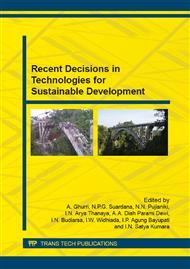[1]
Brusly Solomon, K. Ramachandran (2012). Thermal performance of a heat pipe with nanoparticles coated wick, Applied Thermal Engineering, Vol. 36 10 6e11 2.
DOI: 10.1016/j.applthermaleng.2011.12.004
Google Scholar
[2]
A. J. R. R. Kempers, D. Ewing, C.Y. Ching. (2008) Characterization of evaporator and condenser thermal resistances of a screen mesh wicked heat pipe, International Journal of Heat and Mass Transfer, Vol. 51, 6039-6046.
DOI: 10.1016/j.ijheatmasstransfer.2008.04.001
Google Scholar
[3]
Brian Holley, Amir Faghri (2006). Permeability and effective pore radius measurements for heat pipe and fuel cell applications. Applied Thermal Engineering 26 448–462.
DOI: 10.1016/j.applthermaleng.2005.05.023
Google Scholar
[4]
D. Deng, D. Liang, Y. Tang, J. Peng, X. Han, and M. Pan. (2013) Evaluation of capillary performance of sintered porous wicks for loop heat pipe, Experimental Thermal and Fluid Science.
DOI: 10.1016/j.expthermflusci.2013.04.014
Google Scholar
[5]
D.K. Mishra, T.T. Saravanan, G.P. Khanra, S. Girikumar, S.C. Sharma, K. Sreekumar, P.P. Sinha (2010).
Google Scholar
[6]
J. A. Weibel, S. V. Garimella, and M. T. North, (2010) Characterization of evaporation and boiling from sintered powder wicks fed by capillary action, International Journal of Heat and Mass Transfer, Vol. 53, 4204-4215.
DOI: 10.1016/j.ijheatmasstransfer.2010.05.043
Google Scholar
[7]
J. R. Harris, (2008) Modeling, Designing, Fabricating, and Testing of Channel Panel Flat Plate Heat Pipes, Logan, Masters Thesis.
Google Scholar
[8]
K.C. Leong And C.Y. Liu, (1997) Characterization of Sintered Copper Wicks Used in Heat Pipes, Journal of Porous Materials Vol. 4, 303–308.
Google Scholar
[9]
Mudawar. (2001) Assessment of high-heat-flux thermal management schemes, Components and Packaging Technologies, IEEE Transactions on, Vol. 24, 122-141.
DOI: 10.1109/6144.926375
Google Scholar
[10]
Marcelo Lago, Mariela Araujo (2001). Capillary rises in porous media. Physica A 289 1–17.
Google Scholar
[11]
N. Putra, W. N. Septiadi, and R. Irwansyah, (2013) Effect of Concentration and Loading Fluid of Nanofluids on the Thermal Resistance of Sintered Powder Wick Heat Pipe, Anvanced Material Research.
DOI: 10.4028/www.scientific.net/amr.651.728
Google Scholar
[12]
N. Thuchayapong, A. Nakano, P. Sakulchangsatjatai, and P. Terdtoon, (2012) Effect of capillary pressure on performance of a heat pipe: Numerical approach with FEM, Applied Thermal Engineering, Vol. 32, pp.93-99.
DOI: 10.1016/j.applthermaleng.2011.08.034
Google Scholar
[13]
Reiyu Chein, Guanming Huang. (2004) Thermoelectric cooler application in electronic cooling, Applied Thermal Engineering, Vol. 24, 2207–2217.
DOI: 10.1016/j.applthermaleng.2004.03.001
Google Scholar
[14]
Justin A. Weibel, Suresh V. Garimella (2012). Visualization of vapor formation regimes during capillary-fed boiling in sintered-powder heat pipe wicks. International Journal of Heat and Mass Transfer, Vol. 55 3498–3510.
DOI: 10.1016/j.ijheatmasstransfer.2012.03.021
Google Scholar
[15]
Yong Tang, Daxiang Deng, Longsheng Lu, Minqiang Pan, Qinghui Wang (2010). Experimental investigation on capillary force of composite wick structure by IR thermal imaging camera. Experimental Thermal and Fluid Science, Vol. 34, 190–196.
DOI: 10.1016/j.expthermflusci.2009.10.016
Google Scholar


